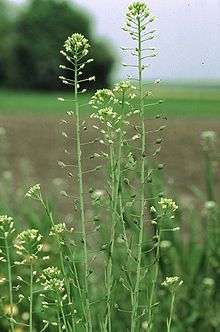Camelina
| Camelina | |
|---|---|
 | |
| Camelina sativa | |
| Scientific classification | |
| Kingdom: | Plantae |
| (unranked): | Angiosperms |
| (unranked): | Eudicots |
| (unranked): | Rosids |
| Order: | Brassicales |
| Family: | Brassicaceae |
| Genus: | Camelina Crantz |
| Species | |
| |
Camelina is a genus within the flowering plant family Brassicaceae. The Camelina species, commonly known as false flax, are native to Mediterranean regions of Europe and Asia. Most species of this genus have been little studied, with the exception of Camelina sativa, historically cultivated as oil plant. Heinrich Johann Nepomuk von Crantz was the first botanist to use the genus Camelina in his classification works in 1762. As a way to reduce fossil fuel emissions, the US Navy tested a 50-50 mix of jet aviation fuel and biofuel derived from camelina seeds in 2010.[1]
Etymology
The name Camelina comes from the Greek for "ground" and "flax", alluding to its being a weed which suppresses the vigour of flax crops.[2]
Botany
Camelina plants are annual or biennial herbs. Their leaves are simple, lanceolate to narrowly elliptic. The flowers are hermaphroditic actinomorphic, grouped in racemes, and yellowish colored. The seeds are formed in dehiscent siliques.[3]
Genetics
The first full genome sequence for Camelina was released on August 1, 2013, by a Canadian research team. The genome sequence and its annotation are available in a genome viewer format and enabled for sequence searching and alignment.[4] Technical details of Camelina's genome sequence were published on April 23, 2014 in the academic journal Nature Communications.[5]
Rothamsted Institute in the UK developed genetically modified Camelina sativa plants that accumulate high levels of fish oils / Omega-3 oils EPA and DHA in their seeds. These plants could provide terrestrial sustainable sources of fish oils and have benefits for human health and the environment.[6] Field trials were underway in 2016.[7]
Species
Four common species are presented below. However, at least two databanks indicate more species may exist.[8][9]
- Camelina alyssum
- Camelina microcarpa
- Camelina rumelica
- Camelina sativa
References
- ↑ "From Seed to Supersonic" (PDF). Currents. US Navy. Winter 2011.
- ↑ http://florabase.dec.wa.gov.au/browse/profile/21468
- ↑ http://www.plantes-botanique.org/genre_Camelina
- ↑ "Camelina sativa Genome Project". Prairie Gold. Retrieved 2013-08-01.
- ↑ "The emerging biofuel crop Camelina sativa retains a highly undifferentiated hexaploid genome structure". Nature Communications. Retrieved 2014-04-23.
- ↑ "Crop plants - "green factories" for fish oils". Rothamsted Research. Retrieved 2016-11-04.
- ↑ "Researchers apply to trial crop of high-yielding GM wheat". Financial Times. 2016-11-05. Retrieved 2016-11-05. (subscription required (help)).
- ↑ http://es.mirror.gbif.org/species/browse/taxon/9321890
- ↑ http://www.theplantlist.org/browse/A/Brassicaceae/Camelina/